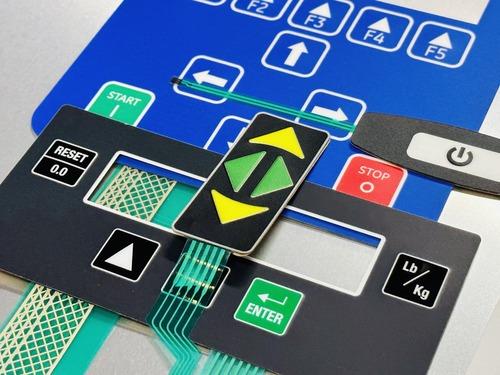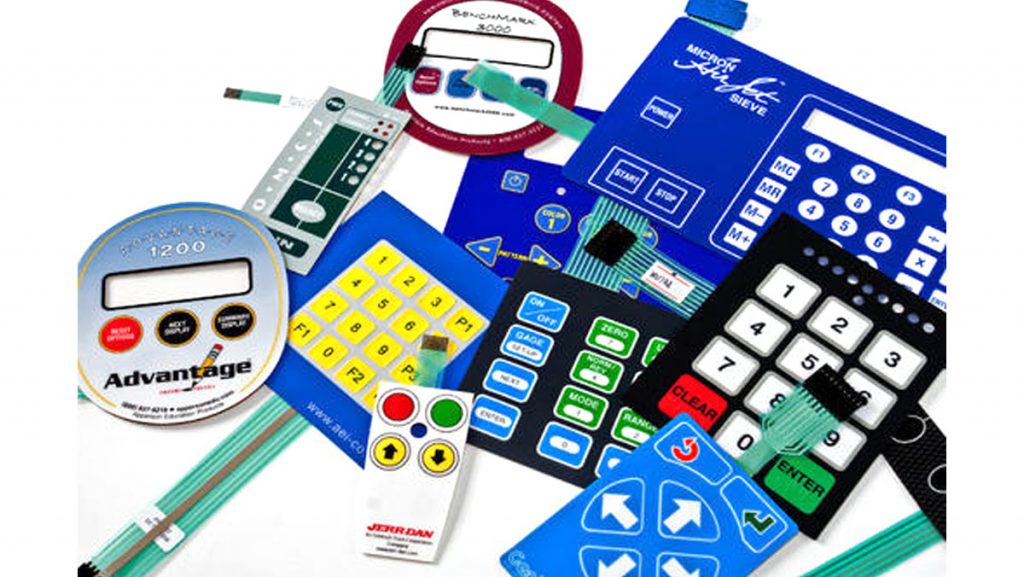Understanding the Technology Behind Membrane Switches
Understanding the Technology Behind Membrane Switches
Blog Article
Recognizing the Value of Membrane Switches in User User Interfaces
Membrane switches are important elements in the design of effective customer interfaces, facilitating not only performance however also improving aesthetic appeal and individual interaction. As we check out the future fads and different advantages connected with Membrane technology, it comes to be clear that these buttons are more than simply elements; they stand for a merging of technology and usefulness.
What Are Membrane Buttons?

The spacer layer, which includes sticky homes, enables the separation of the circuit layer from the overlay, guaranteeing that the button continues to be in a non-activated state up until pressed. When pressure is applied to the overlay, it presses the spacer layer, bridging the gap and completing the circuit in the underlying layer. This layout not only minimizes the physical room needed for traditional mechanical switches but additionally enhances the toughness of the gadget, as Membrane switches are usually immune to dirt, wetness, and various other ecological variables.
Commonly found in applications ranging from consumer electronic devices to medical devices, Membrane switches are important to contemporary technology, offering a effective and straightforward user interface that aligns with modern design requirements.
Benefits of Membrane Buttons
While various switch innovations exist, Membrane Switches deal distinctive benefits that make them specifically desirable in numerous applications. One of the main benefits of Membrane buttons is their portable design, which enables for space-saving executions in gadgets where property is restricted. Their slim profile not only boosts aesthetic allure but also promotes light-weight construction.
An additional substantial advantage is their resistance to environmental variables. Membrane switches are typically sealed versus moisture, dirt, and contaminants, making them perfect for use popular atmospheres, such as clinical gadgets and industrial devices. This resilience prolongs the life expectancy of the switch, reducing upkeep expenses and boosting integrity.
Furthermore, Membrane buttons can be customized to satisfy particular style demands, incorporating distinct graphics and colors that improve customer interaction. Their tactile feedback choices can likewise be customized to supply a satisfying user experience. Furthermore, Membrane switches are cost-effective, especially in high-volume applications, as they can be produced efficiently.
Applications in Numerous Industries

In the consumer electronic devices market, Membrane switches prevail in tools such as microwaves, washing equipments, and push-button controls. Their tactile responses and visual options boost customer experience while providing a smooth, contemporary appearance. In addition, automotive suppliers use Membrane buttons in dashboard controls and infotainment systems, where room is limited, and individual engagement is vital.
Furthermore, the industrial sector leverages Membrane switches in control panels for machinery and tools, enabling for user-friendly procedure in typically rough settings. Their resistance to chemicals and dampness makes sure durability and dependability in these applications. On the whole, the flexibility of Membrane Switches contributes substantially to their prevalent use, making them important in different technological domain names.
Design Factors To Consider for Membrane Switches

When developing Membrane buttons, several vital considerations need to be taken into account to guarantee ideal capability and customer experience. First of all, the selection of products is essential; choosing sturdy, top notch substratums can enhance the switch's durability and resistance to ecological elements such as dampness and temperature fluctuations.
Second of all, the layout of the graphic overlay must prioritize quality and simplicity of usage. Icons and message need to be readable, and the design must assist in intuitive communication (membrane switches). Furthermore, responsive comments is important; including a tactile dome or various other mechanisms can enhance the customer experience by giving physical confirmation of activation
An additional important aspect is the button's electric performance. Designers have to make certain that the conductive traces are correctly created to reduce resistance and stay clear of signal disturbance. This involves evaluating the needed actuation pressure and ensuring compatibility with the electronic components they will certainly interface with.

Future Trends in Membrane Technology
As innovation continues to advancement, Membrane switches are positioned to evolve significantly, driven by innovations in materials and making methods. One emerging pattern is the consolidation of sophisticated products, such as adaptable substratums and conductive inks, which the original source improve longevity and lower the total weight of Membrane buttons. These materials not only enhance the responsive response however additionally allow for the layout of switches that can withstand harsher environmental problems.
In addition, the combination of touch-sensitive modern technologies is transforming standard Membrane Switches right into more he has a good point interactive user interfaces. Capacitive touch sensing units embedded within Membrane button panels can supply an extra receptive and user-friendly customer experience, aligning with the expanding need for smooth, contemporary designs in consumer electronics.
Additionally, improvements in printing strategies, such as digital and 3D printing, make it possible for quick prototyping and personalization of Membrane switches. This adaptability allows makers to react faster to market demands and customer preferences.
Lastly, sustainability is ending up being a substantial focus, with producers exploring eco-friendly products and procedures. As these trends unfold, the future of Membrane innovation promises enhanced capability, aesthetic allure, and environmental obligation, strengthening their duty in sophisticated user interfaces throughout numerous industries.
Conclusion
To conclude, Membrane Switches represent a vital component in the style of customer interfaces, incorporating functionality with aesthetic adaptability. Their advantages, including longevity and resistance to ecological variables, make them suitable for diverse applications throughout different industries. Thoughtful design factors to consider improve customer interaction and experience. As developments in modern technology continue, the evolution of Membrane buttons is expected to more fine-tune individual interfaces, driving innovation and improving use in a significantly complex technical landscape.
Membrane buttons are essential elements in the layout of effective individual interfaces, promoting not only functionality but additionally boosting aesthetic charm and customer interaction.Membrane Switches offer as a crucial part in different individual interfaces, assisting in a smooth interaction in between users and electronic gadgets.While see here numerous button modern technologies exist, Membrane Switches offer distinct benefits that make them especially preferable in various applications.In addition, Membrane switches can be personalized to meet certain style demands, incorporating unique graphics and shades that enhance customer communication.In conclusion, Membrane Switches stand for an essential element in the design of customer interfaces, combining performance with visual flexibility.
Report this page